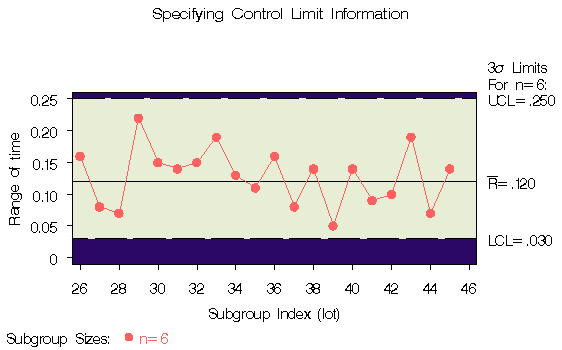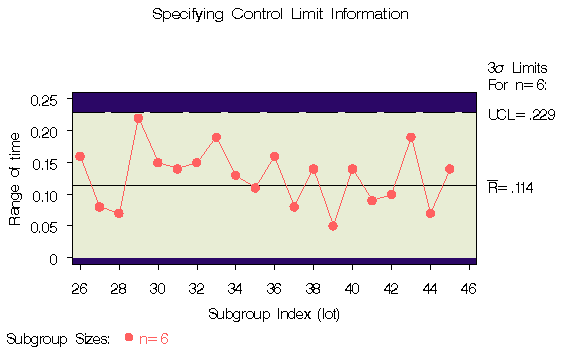Chapter Contents
Previous
Next
|
Chapter Contents |
Previous |
Next |
| RCHART Statement |
| See SHWREX2 in the SAS/QC Sample Library |
This example illustrates how you can use a DATA step program to create a LIMITS= data set. You can provide previously established values for the limits and central line with the variables _LCLR_, _R_, and _UCLR_, as in the following statements:
data dlimits2;
length _var_ _subgrp_ _type_ $8;
_var_ = 'time';
_subgrp_ = 'lot';
_type_ = 'STANDARD';
_limitn_ = 6;
_lclr_ = .03;
_r_ = .12;
_uclr_ = .25;
run;
The following statements* apply the control limits in DLIMITS2 to the measurements in DISKS2 (see "Reading Preestablished Control Limits" ) and create the R chart shown in Output 39.2.1:
title 'Specifying Control Limit Information';
symbol v=dot c=rose;
proc shewhart data=disks2 limits=dlimits2;
rchart time*lot / cframe = vipb
cinfill = ywh
cconnect = rose;
run;
Output 39.2.1: Reading Control Limits from DLIMITS2

|
In some cases, a standard value (![]() ) may be available
for the process standard deviation.
The following DATA step creates a data set named DLIMITS3 that
provides this value:
) may be available
for the process standard deviation.
The following DATA step creates a data set named DLIMITS3 that
provides this value:
data dlimits3;
length _var_ _subgrp_ _type_ $8;
_var_ = 'time';
_subgrp_ = 'lot';
_stddev_ = .045;
_limitn_ = 6;
_type_ = 'STDSIGMA';
run;
The variable _TYPE_ is a bookkeeping variable whose value indicates that the value of _STDDEV_ is a standard value rather than an estimate.
The following statements read the value of ![]() from
DLIMITS3 and create the R chart shown in Output 39.2.2:
from
DLIMITS3 and create the R chart shown in Output 39.2.2:
title 'Specifying Control Limit Information';
symbol v=dot c=rose;
proc shewhart data=disks2 limits=dlimits3;
rchart time*lot / nolimit0
cframe = vipb
cinfill = ywh
cconnect = rose;
run;
The NOLIMIT0 option suppresses the display of a fixed lower
control limit if the value of the limit is zero (which
is the case in this example).

|
proc shewhart data=disks;
rchart time*lot / sigma0=.045 nolimit0;
run;
For more information, see "LIMITS= Data Set" .
|
Chapter Contents |
Previous |
Next |
Top |
Copyright © 1999 by SAS Institute Inc., Cary, NC, USA. All rights reserved.